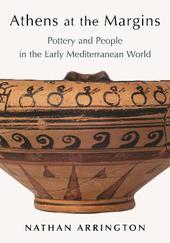
|
Athens at the Margins: Pottery and People in the Early Mediterranean World
Hardback
Main Details
| Title |
Athens at the Margins: Pottery and People in the Early Mediterranean World
|
| Authors and Contributors |
By (author) Nathan T. Arrington
|
| Physical Properties |
| Format:Hardback | | Pages:344 | | Dimensions(mm): Height 254,Width 178 |
|
| Category/Genre | Archaeology |
|---|
| ISBN/Barcode |
9780691175201
|
| Classifications | Dewey:738.309385 |
|---|
| Audience | | Tertiary Education (US: College) | | Professional & Vocational | |
|---|
| Illustrations |
138 b/w illus., 16 color illus. (8-page insert)
|
|
Publishing Details |
| Publisher |
Princeton University Press
|
| Imprint |
Princeton University Press
|
| Publication Date |
19 October 2021 |
| Publication Country |
United States
|
Description
How the interactions of nonelites influenced Athenian material culture and society The seventh century BC in ancient Greece is referred to as the Orientalizing period because of the strong presence of Near Eastern elements in art and culture. Conventional narratives argue that goods and knowledge flowed from East to West through cosmopolitan eli
Author Biography
Nathan T. Arrington is associate professor of Greek art and archaeology at Princeton University. He is the author of Ashes, Images, and Memories: The Presence of the War Dead in Fifth-Century Athens.
Reviews"With its copious fine illustrations and lucid exposition, this is an extraordinary resource for the teacher of Greek archaeology."---Robin Osborne, World Archaeology "In this significant reinterpretation, Arrington convincingly maintains that material culture and knowledge did not flow from East to West just through multiethnic elites; it also flowed through the interactions of non-elites."---C. C. Kolb, Choice Reviews "In his wonderfully stimulating book, Nathan Arrington has the people on the margins of 7th-century Attica have their voices roaring back into the debate. . . . [It] should be read by anyone interested in the subaltern perspective, artistry and pottery, as well as the historiography behind many of the discipline's accepted assumptions."---Roy van Wijk, The Classical Journal "This is an inspiring book. It is not only well researched, nicely illustrated and elegantly written, but it offers a whole range of new perspectives on the Protoattic style and its wider context, with the objects themselves (and their agency) taking center stage."---Maximilian Roennberg, Bryn Mawr Classical Review "Thought-provoking and ambitious...[t]his unconventional volume - beautifully phrased and engagingly written - is very clear and well structured, with numerous high-quality images helping readers to follow [Arrington's] descriptions and readings of the vases."---Adriano Orsingher, The Classical Review "[A] beautifully written book, based on substantial and thorough research. . . . Moving away from the "Orientalizing" paradigm, Arrington succeeds in bringing to the forefront artists, immigrants, and multicultural communities, while challenging the elite connotations of the Proto-Attic pottery. This book, well produced and richly illustrated, is a positive contribution to the literature on seventh-century BCE Attica for students and scholars alike."---Vicky Vlachou, American Journal of Archaeology
|